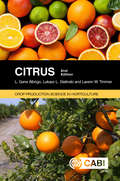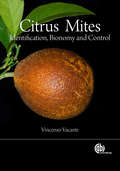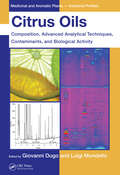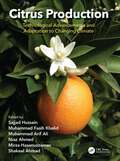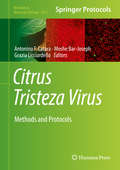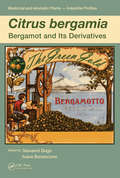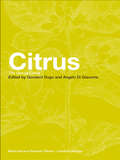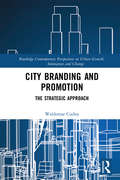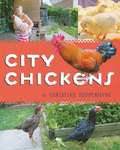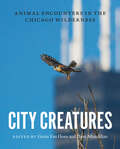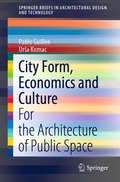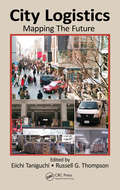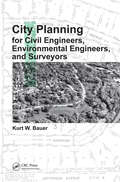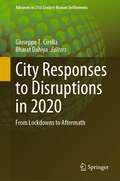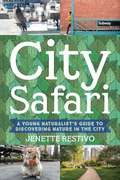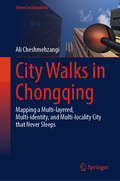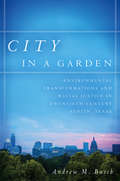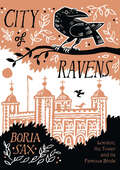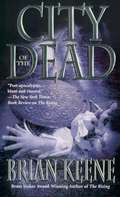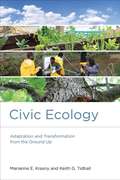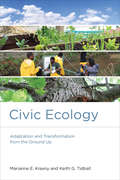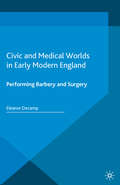- Table View
- List View
Citrus (Crop Production Science In Horticulture Ser.)
by L. Gene Albrigo Dr Lukasz L. Stelinski Lavern TimmerCitrus fruit, originating in Southeast Asia, have been cultivated and enjoyed for over 4000 years. Moreover, they are grown in nearly every country within 40°north-south latitude, the major producers being China, Brazil, the USA, and countries bordering the Mediterranean. This new edition continues to adopt an international perspective on citrus, covering its biology and cultivation as well as considering issues in the citrus industry and providing examples from around the world. The authors include discussion on important topics such as biotechnical advances in citrus genetics, current techniques in breeding, the role of climatic factors in worldwide production, the importance of rootstocks, plant husbandry, pests and diseases, and postharvest technology. They emphasize current theories and technological advances in citriculture, citing specific examples of how they are used and in which regions. Citrus 2nd edition describes the scientific basis of production practices and is aimed at professionals in the industry as well as advanced students of horticulture and allied disciplines within plant science and food science.
Citrus Genetics, Breeding and Biotechnology
by Iqrar Ahmad KhanThis book provides a comprehensive review of citrus breeding, including relevant genetics, molecular biology and biotechnology.
Citrus Mites: Identification, Bionomy and Control
by Vincenzo VacanteCitrus pests are a serious issue for crop growers, causing problems in yield and economic losses. Citrus Mites is a comprehensive study of mites harmful to citrus plants from all citrus growing regions around the world. Providing a useful resource for identifying citrus crop pests, the text will also address methods of removal from plants, describe symptoms of damage caused by pests and discuss methods of eradication and control, making it essential for horticulturalists, pomologists and acarologists as well as practitioners, researchers and students of crop protection and pest management.
Citrus Oils: Composition, Advanced Analytical Techniques, Contaminants, and Biological Activity (Medicinal and Aromatic Plants - Industrial Profiles)
by Luigi Mondello Giovanni DugoWorld production of citrus fruits is still growing. At present, about 30 percent of that yield is devoted to industrial production, mostly on those essential oils and juices used in foods, pharmaceuticals, and cosmetics. Covering research reported in the literature over the past ten years, this book presents the most current research available
Citrus Production: Technological Advancements and Adaptation to Changing Climate
by Mirza Hasanuzzaman Sajjad Hussain Shakeel Ahmad Niaz Ahmed Muhammad Fasih Khalid Muhammad Arif AliThe citrus industry is one of the world's most important fruit production industries, but global climate change, pests, diseases, and improper handling are affecting plant yields. Citrus Production: Technological Advancements and Adaptation to Changing Climate presents information on advancements in the citrus industry examining various aspects of citrus from its production to harvest. It looks at the challenges and approaches in stress tolerance improvements, increasing citrus crop productivity, and reducing postharvest losses. The book details taxonomy, genetic diversity, and metabolic and molecular responses in citrus crops, as well as abiotic and biotic stresses affecting citrus production. Featuring numerous full-color illustrations throughout, this book poses new harvesting techniques along with postharvest physiology of citrus fruits, devising strategies to prevent crop losses. Citrus Production: Technological Advancements and Adaptation to Changing Climate is an essential resource for researchers, academicians, and scientists looking to expand their knowledge of citrus, particularly horticulturists, food scientists, and botanists.
Citrus Tristeza Virus: Methods and Protocols (Methods in Molecular Biology #2015)
by Antonino F. Catara Moshe Bar-Joseph Grazia LicciardelloThis book provides methods and clear protocols for the various technologies available to detect, characterize, and study Citrus tristeza virus (CTV), a member of the genus Closterovirus, family Closteroviridae. Thanks to the highly sensitive and specific diagnostic procedures developed, knowledge of the molecular characteristics, expression strategies, genetic variability, and epidemiology of the virus has improved significantly, as this volume reflects. Written for the highly successful Methods in Molecular Biology series, chapters include introductions to their respective topics, lists of the necessary materials and reagents, step-by-step, readily reproducible laboratory protocols, and tips on troubleshooting and avoiding known pitfalls. Authoritative and practical, Citrus Tristeza Virus: Methods and Protocols serves as an ideal guide for plant pathologists, plant virologists, molecular biologists, and graduate students interested in performing qualitative and quantitative tests as well as recently-developed diagnostic methods in order to find solutions to improve the management of this disease.
Citrus bergamia: Bergamot and its Derivatives
by Giovanni Dugo Ivana BonaccorsiIn Calabria, Italy, where bergamot has been successfully cultivated since the eighteenth century, it is commonly defined as "the prince of the Citrus genus." Written by an international panel of experts from multiple disciplines, Citrus bergamia: Bergamot and its Derivatives represents the most complete treatise on bergamot and its derivatives curr
Citrus: The Genus Citrus (Medicinal And Aromatic Plants - Industrial Profiles Ser.)
by Giovanni Dugo Angelo Di GiacomoThe world production of citrus fruit has risen enormously, leaping from forty-five million tons a year to eighty-five million in the last 30 years. Today, the potential applications of their essential oils are growing wider, with nearly 40% of fresh produce processed for industrial purposes.Citrus: The Genus Citrus offers comprehensive cove
City Adrift: New Orleans Before and After Katrina
by Dan Rather Center for Public IntegrityHurricane Katrina was a stunning example of complete civic breakdown. Beginning on August 29, 2005, the world watched in horror as -- despite all the warnings and studies -- every system that might have protected New Orleans failed. Levees and canals buckled, pouring more than 100 billion gallons of floodwater into the city. Botched communications crippled rescue operations. Buses that might have evacuated thousands never came. Hospitals lost power, and patients lay suffering in darkness and stifling heat. At least 1,400 Louisianans died in Hurricane Katrina, more than half of them from New Orleans, and hundreds of thousands more were displaced, many still wondering if they will ever be able to return. How could all of this have happened in twenty-first-century America? And could it all happen again?To answer these questions, the Center for Public Integrity commissioned seven seasoned journalists to travel to New Orleans and investigate the storm's aftermath. In City Adrift: New Orleans Before and After Katrina, they present their findings. The stellar roster of contributors includes Pulitzer Prize-winner John McQuaid, whose earlier work predicted the failure of the levees and the impending disaster; longtime Boston Globe newsman Curtis Wilkie, a French Quarter resident for nearly fifteen years; and Katy Reckdahl, an award-winning freelance journalist who gave birth to her son in a New Orleans hospital the day before Katrina hit.They and the rest of the investigative team interviewed homeowners and health officials, first responders and politicians, and evacuees and other ordinary citizens to explore the storm from numerous angles, including health care, social services, housing and insurance, and emergency preparedness. They also identify the political, social, geographical, and technological factors that compounded the tragedy. Comprehensive and balanced, City Adrift provides not only an assessment of what went wrong in the Big Easy during and following Hurricane Katrina, but also, more importantly, a road map of what must be done to ensure that such a devastating tragedy is never repeated.
City Branding and Promotion: The Strategic Approach (Routledge Contemporary Perspectives on Urban Growth, Innovation and Change)
by Waldemar CudnyThis book explores theoretical concepts of strategic promotion and place branding in cities. It outlines the issues associated with strategic management of urban territories and highlights various types of development strategies that seek to encourage socio-economic development, growth and city branding, particularly within the tourism industry. It examines the rules and methods for analysing the current branding of a city and how new branding and promotion strategies are created. Through a range of international examples the book considers the missions, aims and implementation of branding strategies and the importance of monitoring and controlling procedures. The first part of the book provides theoretical context, followed by a detailed exploration of the promotional and branding strategy prepared for the city of Tomaszów Mazowiecki in Poland. This book provides the reader with theoretical and practical insights on city branding and will appeal to scholars and students in urban studies, geography, tourism, management and economics.
City Creatures: Animal Encounters in the Chicago Wilderness
by Gavin Van Horn Dave AftandilianWe usually think of cities as the domain of humans--but we are just one of thousands of species that call the urban landscape home. Chicago residents knowingly move among familiar creatures like squirrels, pigeons, and dogs, but might be surprised to learn about all the leafhoppers and water bears, black-crowned night herons and bison, beavers and massasauga rattlesnakes that are living alongside them. City Creatures introduces readers to an astonishing diversity of urban wildlife with a unique and accessible mix of essays, poetry, paintings, and photographs. The contributors bring a story-based approach to this urban safari, taking readers on birding expeditions to the Magic Hedge at Montrose Harbor on the North Side, canoe trips down the South Fork of the Chicago River (better known as Bubbly Creek), and insect-collecting forays or restoration work days in the suburban forest preserves. The book is organized into six sections, each highlighting one type of place in which people might encounter animals in the city and suburbs. For example, schoolyard chickens and warrior wasps populate "Backyard Diversity," live giraffes loom at the zoo and taxidermy-in-progress pheasants fascinate museum-goers in "Animals on Display," and a chorus of deep-freeze frogs awaits in "Water Worlds. " Although the book is rooted in Chicago's landscape, nature lovers from cities around the globe will find a wealth of urban animal encounters that will open their senses to a new world that has been there all along. Its powerful combination of insightful narratives, numinous poetry, and full-color art throughout will help readers see the city--and the creatures who share it with us--in an entirely new light.
City Form, Economics and Culture: For the Architecture of Public Space (SpringerBriefs in Architectural Design and Technology)
by Pablo Guillen Urša KomacThis is a book about how cities occupy space. We are not interested in architectural masterpieces, but the tools for reinventing city life. We try to provide a framework for the architecture and design of public space without aesthetic considerations. We identify several defining factors. First of all, history as the city today very much depends on how it was yesterday. The geographical location and the technology available at a point of time both play a constraining role in what can be done as well. Culture, in the form of social norms, laws and regulations, also restricts what is possible to do. On the other hand, culture is also important in guiding the ideas and aspirations that together inform what society wants the city to be. The city needs government intervention, or regulation, to ameliorate the problem posed by a tangle of externalities and public goods. We focus on two comparative case studies: the evolution of urban form in the US and how it stands in a sharp contrast with the evolution of urban form in Japan. We emphasise the difference in regulations between both jurisdictions. We study how differences in technological choices driven by culture (i.e. racial segregation), geography (i.e. the availability of land) and history (i.e. the mobility restrictions of the Tokugawa period) result in vast differences in mobility regarding the share of public transport, walking and cycling versus motorised private transport. American cities are constrained by rules that are much further from the neoliberal economic idea of free and competitive markets than the Japanese ones. Japanese planning promotes competition and through a granular, walkable city dotted with small shops, fosters variety in the availability of goods and services. We hypothesise how changing regulations could change the urban form to generate a greater variety of goods and to foster the access to those goods through a more equitable distribution of wealth. Critically, we point out that a desirably denser city must rely on public transport, and we also study how a less-dense city can be made to work with public transport. We conclude by claiming that changes in regulations are very unlikely to happen in the US, as it would require deep cultural changes to move from local to a more universal and less excluding public good provision, but they are both possible and desirable in other jurisdictions.
City Logistics: Mapping The Future
by Eiichi Taniguchi Russell G. ThompsonCity Logistics: Mapping The Future examines the key concepts of city logistics along with the associated implementation issues, methodologies, and policy measures. Chronicling the growth of city logistics as a discipline and how planning and policy have improved practice over the last ten years, it details the technologies, policies, and plans that
City Planning for Civil Engineers, Environmental Engineers, and Surveyors
by Kurt W. BauerWhile engineers and surveyors are not urban planners, they are often engaged in urban development. Therefore, a high degree of competence in civil engineering specialties such as surveying and mapping, highway and transportation engineering, water resources engineering, environmental engineering, and, particularly, municipal engineering requires an
City Responses to Disruptions in 2020: From Lockdowns to Aftermath (Advances in 21st Century Human Settlements)
by Bharat Dahiya Giuseppe T. CirellaThis book presents the integrating of economics and urban geography to create a framework of cooperation around the idea of urban economic stability. It explores these disciplines through the economic lens and creates a collaborative environment for addressing the global challenges caused by the COVID-19 pandemic and future global shocks. Environmental advocates and proponents of economic growth are increasingly at odds—having looked at the economic impact of the decline of the environment as well as the environmental loss that occurs with unchecked growth and urbanization. The outbreak of the COVID-19 pandemic changed the global scene. The world shook in its foundations, as a number of countries’ lockdown affected not only the global economy but also society and the environment. The global community has seen the negative impact of COVID-19 on our economies. There have been steep declines in gross domestic product, job losses have been in the millions, and people have seen their incomes fall. An unplanned shutdown has taken its toll and has been a shock to the economies of the world. Past shocks and how they have impacted urban economies as well as for how long are core to bettering our understanding of present and future urban economic change. The underlying economic factors that make a shock more damaging to certain economies or industries, as well as understanding these vulnerabilities, help entities recover from economic shocks and allow them to better understand how impacts on individual businesses can be implemented. The pandemic revealed the need to adopt a global development approach, taking into consideration four dimensions: global value chains, debt, digitalization, and the environment. Topics related to the causation and lockdown are explored through a number of case studies from around the world.
City Safari: A Young Naturalist's Guide to Discovering Nature in the City
by Jenette RestivoCity Safari invites young explorers to look beyond the concrete and see their city in a whole new light. At first glance, a city block might seem like a gray wasteland—cracked sidewalks, over-trimmed trees, endless buildings. But look a little closer, and a hidden world comes to life.High above, squirrels nest in tangled treetops. Raptors perch on skyscraper ledges. Pigeons raise chicks on parking garage beams. An owl might be dozing in a hollow tree, and a crevice in a stone wall could be the front door to a rodent&’s home. Urban nature is everywhere—if you know how to find it.Part natural history guide, part adventure manual, City Safari helps middle-grade readers become urban naturalists, developing a sharp eye for wildlife hiding in plain sight. With engaging facts, fieldwork activities, and a fresh perspective on everyday surroundings, this book turns the city into a thrilling wilderness waiting to be discovered.
City Walks in Chongqing: Mapping a Multi-layered, Multi-identity, and Multi-locality City that Never Sleeps (Urban Sustainability)
by Ali CheshmehzangiCity walks enable us to think and feel more intricately, and by living through them – hopefully less ostentatiously - through experiences and relations that genuinely matter. This sort of spatial syntagma is made of many correlations based on knowing what happens in cities, feeling what attributes are important, and articulating a set of relations to develop socio-spatial inter-relations and, ultimately, identities. In a way, &“city walks&” should empower cities to talk penetratingly while we hear, feel, and observe through experiences and thinking. Hence, city walks help the city talk. The City of Chongqing means a lot to me. It is a city that allows you to fall in love with a sense of urbanity for city life and experiences. It is a city that creates a distinguishable set of relations, both transient and abiding in many ways. It is a city with a different tone of heartbeat during the day and the night, a sort of vibration that lives through many arteries at different nodes, settings, and connections. It is a city of multiple networks - different from many other cities - that never sleeps. Most importantly, Chongqing has a unique magnitude of everything that a city can offer. It is a city that can be experienced differently every time you visit it, and you can live through those diminutive experiences via greater connections and expounded senses that exist but have to be experienced first. In this book, Chongqing is studied based on its sophistication of having multiple layers, multiple identities, and multiple localities. Hence, it is structured based on these three crucial aspects, including (urban) values, attributes, experiences, and livelihoods of Chongqing. This book is the first of its kind for a Chinese city and is aimed to reveal a genuine gem while accentuating with pride a city that never sleeps. This should be read and understood by scholars, urban researchers, and urban specialists seeking to develop better cities and communities. &“Just Brilliant! Chongqing has never been portrayed any better than this book does so miraculously&”. - Tian Tang, Independent Researcher, China &“Another unique mapping study by the author; and this time, through sensory and perceptible city walks of a global city – the beautiful city of Chongqing&”. - Aaron Golden, Independent Researcher, UK
City in a Garden: Environmental Transformations and Racial Justice in Twentieth-Century Austin, Texas
by Andrew M. BuschThe natural beauty of Austin, Texas, has always been central to the city's identity. From the beginning, city leaders, residents, planners, and employers consistently imagined Austin as a natural place, highlighting the region's environmental attributes as they marketed the city and planned for its growth. Yet, as Austin modernized and attracted an educated and skilled labor force, the demand to preserve its natural spaces was used to justify economic and racial segregation. This effort to create and maintain a "city in a garden" perpetuated uneven social and economic power relationships throughout the twentieth century.In telling Austin's story, Andrew M. Busch invites readers to consider the wider implications of environmentally friendly urban development. While Austin's mainstream environmental record is impressive, its minority groups continue to live on the economic, social, and geographic margins of the city. By demonstrating how the city's midcentury modernization and progressive movement sustained racial oppression, restriction, and uneven development in the decades that followed, Busch reveals the darker ramifications of Austin's green growth.
City of Ravens: London, the Tower and its Famous Birds
by Boria SaxA “quirky and absorbing” exploration of the history and mythology surrounding the ravens at the Tower of London (Publishers Weekly).Tales tell of how Charles II, fearful of ancient legends that Britain will fall if the ravens at the Tower of London ever leave their abode, ordered that the wings of the six ravens be clipped. But the truth is that the ravens only arrived at the Tower in 1883, when they were brought in as props in tales of Gothic horror that were told to tourists. The legend itself originated from the summer of 1944, when ravens in London were used as unofficial spotters for enemy bombs and planes. Boria Sax gives us the first book to tell the true story of the ravens, which has far more high drama than any of the tales the tourists get to hear. Its heroes are the raven couple Grip and Mable, who eloped from the Tower together after World War II, leaving it empty and prompting fears that the British Empire would end; Jackie, who kept watch at a brewery; McDonald, who was murdered; and Thor, who could not accept his loss of flight. For over a century, the ravens have been symbols of cruelty, avatars of fate—and cuddly national pets. But Sax shows us how the ravens have come to represent Britain’s natural heritage, without which any nation would be impoverished. This informing and reflective volume addresses the need to connect with animals and the natural world and shows us the human need for wonder at nature.Praise for City of Ravens“Both a delight and a profound illumination of the subject . . . with unexpected and fascinating conclusions.” —Esther Woolfson, author of Corvus“A wonderful contribution to the modern history and mythology of one of the world’s greatest cities.” —Ronald Hutton, Commissioner of English Heritage“Boria Sax traces the history of the ravens in the Tower of London with accurate scholarship and engaging stories.” —John Marzluff, co-author of In the Company of Crows and Ravens“The author delves into the true history and cultural importance of these massive corvids. It’s a lively, entertaining tale, with a few grisly details from real events.” —Anna Sanders, Audubon Magazine
City of the Dead
by Brian KeeneSequel to The Rising. Cities have become overrun with legions of the dead. A group of human survivors trapped in a skyscraper prepare to make their last stand against an unstoppable undying enemy.
Cityscape in the Era of Information and Communication Technologies (The Urban Book Series)
by Agata BonenbergThis book discusses the impact of information and communication technologies, particularly social media, on the structure and landscape of contemporary cities. It presents a multidisciplinary range of theories and practical case studies and addresses a broad readership, from graduate students to practitioners active in the fields of urbanism and the architectural design of urban space. The book includes a wealth of illustrations depicting contemporary architecture and exemplary modern public spaces, as well as diagrams and tables that optimally visualize the concepts and ideas discussed.
Civic Ecology
by Marianne E. Krasny Keith G. TidballIn communities across the country and around the world, people are coming together to rebuild and restore local environments that have been affected by crisis or disaster. In New Orleans after Katrina, in New York after Sandy, in Soweto after apartheid, and in any number of postindustrial, depopulated cities, people work together to restore nature, renew communities, and heal themselves. In Civic Ecology, Marianne Krasny and Keith Tidball offer stories of this emerging grassroots environmental stewardship, along with an interdisciplinary framework for understanding and studying it as a growing international phenomenon. Krasny and Tidball draw on research in social capital and collective efficacy, ecosystem services, social learning, governance, social-ecological systems, and other findings in the social and ecological sciences to investigate how people, practices, and communities interact. Along the way, they chronicle local environmental stewards who have undertaken such tasks as beautifying blocks in the Bronx, clearing trash from the Iranian countryside, and working with traumatized veterans to conserve nature and recreate community. Krasny and Tidball argue that humans' innate love of nature and attachment to place compels them to restore nature and places that are threatened, destroyed, or lost. At the same time, they report, nature and community exert a healing and restorative power on their stewards.
Civic Ecology: Adaptation and Transformation from the Ground Up (Urban and Industrial Environments)
by Marianne E. Krasny Keith G. TidballStories of environmental stewardship in communities from New Orleans to Soweto accompany an interdisciplinary framework for understanding civic ecology as a global phenomenon.In communities across the country and around the world, people are coming together to rebuild and restore local environments that have been affected by crisis or disaster. In New Orleans after Katrina, in New York after Sandy, in Soweto after apartheid, and in any number of postindustrial, depopulated cities, people work together to restore nature, renew communities, and heal themselves. In Civic Ecology, Marianne Krasny and Keith Tidball offer stories of this emerging grassroots environmental stewardship, along with an interdisciplinary framework for understanding and studying it as a growing international phenomenon. Krasny and Tidball draw on research in social capital and collective efficacy, ecosystem services, social learning, governance, social-ecological systems, and other findings in the social and ecological sciences to investigate how people, practices, and communities interact. Along the way, they chronicle local environmental stewards who have undertaken such tasks as beautifying blocks in the Bronx, clearing trash from the Iranian countryside, and working with traumatized veterans to conserve nature and recreate community. Krasny and Tidball argue that humans' innate love of nature and attachment to place compels them to restore nature and places that are threatened, destroyed, or lost. At the same time, they report, nature and community exert a healing and restorative power on their stewards.
Civic and Medical Worlds in Early Modern England: Performing Barbery and Surgery (Early Modern Literature in History)
by E. DecampThrough its rich foray into popular literary culture and medical history, this book investigates representations of regular and irregular medical practice in early modern England. Focusing on the prolific figures of the barber, surgeon and barber-surgeon, the author explores what it meant to the early modern population for a group of practitioners to be associated with both the trade guilds and an emerging professional medical world. The book uncovers the differences and cross-pollinations between barbers and surgeons' practices which play out across the literature: we learn not only about their cultural, civic, medical and occupational histories but also about how we should interpret patterns in language, name choice, performance, materiality, acoustics and semiology in the period. The investigations prompt new readings of Shakespeare, Jonson, Middleton and Beaumont, among others. And with chapters delving into early modern representations of medical instruments, hairiness, bloodletting procedures, waxy or infected ears, wart removals and skeletons, readers will find much of the contribution of this book is in its detail, which brings its subject to life.
